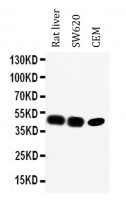ARG42685
anti-CD196 / CCR6 antibody
anti-CD196 / CCR6 antibody for Western blot and Human,Rat
Overview
| Product Description | Rabbit Polyclonal antibody recognizes CD196 / CCR6 |
|---|---|
| Tested Reactivity | Hu, Rat |
| Predict Reactivity | Ms, Dog, Mk |
| Tested Application | WB |
| Host | Rabbit |
| Clonality | Polyclonal |
| Isotype | IgG |
| Target Name | CD196 / CCR6 |
| Antigen Species | Human |
| Immunogen | Synthetic peptide corresponding to aa. 358-374 of Human CD196 / CCR6. (RQTSETADNDNASSFTM) |
| Conjugation | Un-conjugated |
| Alternate Names | C-C chemokine receptor type 6; CD196; CD antigen CD196; CKRL3; CCR-6; GPR-CY4; BN-1; DCR2; Chemokine receptor-like 3; CC-CKR-6; CKR-L3; GPR29; G-protein coupled receptor 29; CMKBR6; C-C CKR-6; DRY6; GPRCY4; LARC receptor; STRL22 |
Application Instructions
| Application Suggestion |
|
||||
|---|---|---|---|---|---|
| Application Note | * The dilutions indicate recommended starting dilutions and the optimal dilutions or concentrations should be determined by the scientist. | ||||
| Observed Size | ~ 45 kDa |
Properties
| Form | Liquid |
|---|---|
| Purification | Affinity purification with immunogen. |
| Buffer | 0.2% Na2HPO4, 0.9% NaCl, 0.05% Sodium azide and 4% Trehalose. |
| Preservative | 0.05% Sodium azide |
| Stabilizer | 4% Trehalose |
| Concentration | 0.5 mg/ml |
| Storage Instruction | For continuous use, store undiluted antibody at 2-8°C for up to a week. For long-term storage, aliquot and store at -20°C or below. Storage in frost free freezers is not recommended. Avoid repeated freeze/thaw cycles. Suggest spin the vial prior to opening. The antibody solution should be gently mixed before use. |
| Note | For laboratory research only, not for drug, diagnostic or other use. |
Bioinformation
| Database Links | |
|---|---|
| Gene Symbol | CCR6 |
| Gene Full Name | chemokine (C-C motif) receptor 6 |
| Background | This gene encodes a member of the beta chemokine receptor family, which is predicted to be a seven transmembrane protein similar to G protein-coupled receptors. The gene is preferentially expressed by immature dendritic cells and memory T cells. The ligand of this receptor is macrophage inflammatory protein 3 alpha (MIP-3 alpha). This receptor has been shown to be important for B-lineage maturation and antigen-driven B-cell differentiation, and it may regulate the migration and recruitment of dentritic and T cells during inflammatory and immunological responses. Alternatively spliced transcript variants that encode the same protein have been described for this gene. [provided by RefSeq, Jul 2008] |
| Function | Receptor for the C-C type chemokine CCL20 (PubMed:9169459). Binds to CCL20 and subsequently transduces a signal by increasing the intracellular calcium ion levels (PubMed:20068036). Although CCL20 is its major ligand it can also act as a receptor for non-chemokine ligands such as beta-defensins (PubMed:25585877). Binds to defensin DEFB1 leading to increase in intracellular calcium ions and cAMP levels. Its binding to DEFB1 is essential for the function of DEFB1 in regulating sperm motility and bactericidal activity (PubMed:25122636). Binds to defensins DEFB4 and DEFB4A/B and mediates their chemotactic effects (PubMed:20068036). The ligand-receptor pair CCL20-CCR6 is responsible for the chemotaxis of dendritic cells (DC), effector/ memory T-cells and B-cells and plays an important role at skin and mucosal surfaces under homeostatic and inflammatory conditions, as well as in pathology, including cancer and various autoimmune diseases. CCR6-mediated signals are essential for immune responses to microbes in the intestinal mucosa and in the modulation of inflammatory responses initiated by tissue insult and trauma (PubMed:21376174). CCR6 is essential for the recruitment of both the proinflammatory IL17 producing helper T-cells (Th17) and the regulatory T-cells (Treg) to sites of inflammation. Required for the normal migration of Th17 cells in Peyers-patches and other related tissue sites of the intestine and plays a role in regulating effector T-cell balance and distribution in inflamed intestine. Plays an important role in the coordination of early thymocyte precursor migration events important for normal subsequent thymocyte precursor development, but is not required for the formation of normal thymic natural regulatory T-cells (nTregs). Required for optimal differentiation of DN2 and DN3 thymocyte precursors. Essential for B-cell localization in the subepithelial dome of Peyers-patches and for efficient B-cell isotype switching to IgA in the Peyers-patches. Essential for appropriate anatomical distribution of memory B-cells in the spleen and for the secondary recall response of memory B-cells (By similarity). Positively regulates sperm motility and chemotaxis via its binding to CCL20 (PubMed:23765988). [UniProt] |
| Cellular Localization | Cell membrane; Multi-pass membrane protein. Cell surface. [UniProt] |
| Calculated MW | 42 kDa |
Images (1) Click the Picture to Zoom In






